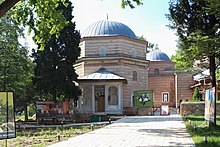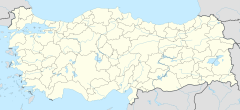This article needs additional citations for verification. (May 2017) |
The Muradiye Complex (Turkish: Muradiye Külliyesi) or the Complex of Sultan Murad II, the Ottoman sultan (reigned 1421–1451, with interruption 1444–46), is located in Bursa, Turkey. It is part of the historic UNESCO World Heritage Site.[1]
| Muradiye Complex | |
|---|---|
Muradiye Külliyesi | |
 The Muradiye Complex | |
| Religion | |
| Affiliation | Islam |
| Location | |
| Location | Bursa, Turkey |
| Geographic coordinates | 40°11′27″N 29°02′46″E / 40.190853°N 29.046144°E |
| Architecture | |
| Type | Mosque |
| Style | Islamic, Ottoman architecture |
| Completed | 1426 |
| Minaret(s) | 2 |
| Part of | Bursa and Cumalıkızık: the Birth of the Ottoman Empire |
| Criteria | Cultural: (i), (ii), (iv), (vi) |
| Reference | 1452-007 |
| Inscription | 2014 (38th Session) |
History
editThe mosque complex commissioned by Sultan Murad II in Bursa contains twelve tombs (türbe), most belonging to relatives of this sultan.[2] Construction of the complex began after the completion of the Yeşil Mosque, which is in the eastern area of Bursa. A large earthquake in 1855 damaged much of the Muradiye complex, and restorations were completed in the late nineteenth century.[3] A further restoration project was completed in 2015.[4]
The large complex is composed of the Muradiye Mosque, Muradiye Madrasa, Muradiye Bath, Muradiye Hospice, a fountain, epitaphs, and numerous tombs, among others: Sultan Murad II's tomb, Şehzade Ahmed's tomb, Cem Sultan's tomb,[5] Şehzade Mustafa's tomb, Mahidevran Hatun's tomb, Gülşah Hatun's tomb, Hüma Hatun's tomb, Sittişah Hatun's tomb, the Saraylilar's tomb, and Şirin Hatun's tomb.[6]
The Mosque was the first project in the complex, completed in 1426. The mosque is built in a simplified inverse T plan with a domed portico in front, constructed of brick and with four major domes.[7] Hexagonal tiles in turquoise and dark blue decorate the interior. There are two minarets, one that is old and one that is new due to collapse from the 19th century earthquake and was rebuilt in 1904. A fire damaged the mosque in the early 18th century, and so the mihrab was also rebuilt, in the rococo style.
The madrasa is located to the west of the mosque. It is composed of a central courtyard surrounded by student rooms and a classroom to the back, covered by a dome. The exterior is brick and stone. The madrasa itself does not have a construction inscription due to numerous restorations. The inscription on the mosque says the madrasa was also constructed in 1426 by Murad II.[8] Dark blue and turquoise tiles decorate the interior, while brick decorates the exterior entrance.
Sources conflict on the date of construction for the tomb of Murad II, either before his death in 1451, or after commissioned by his son Mehmed II in accordance with Murad II's will.[9] The building is constructed of brick and stone, in a square plan topped with a dome that is left open at the top. A vaulted gallery surrounds the dome, resting on Byzantine capitals. A large impressive wooden canopy over the entrance is carved in relief and embellished in star patterns. An annex contains four additional tombs, identified as those of Aladdin Ali (whom the annex is named after, “Mausoleum of Alaaddin”), Şehzade Ahmet,[10] Orhan and Şehzade Hatun.
The remaining eleven tombs belong to the rest of the sultan's family to the south of the mosque and the madrasa. They are decorated with polychrome glazed tiles mostly in blue, except for the tombs of Şehzade Mustafa and Mahidevran Hatun which is decorated in painted Iznik tiles from the 16th century in the polychrome technique.
In the 1950s the madrasa became a tuberculosis clinic and it now houses a medical centre.[11]
Gallery
edit-
Front of Cem Sultan tomb
-
Interior Cem Sultan tomb
-
Interior Cem Sultan tomb
-
Interior Cem Sultan tomb
-
Entrance to Gülşah Hatun tomb
-
Interior Gülşah Hatun tomb
-
Hüma Hatun tomb interior
-
Hüma Hatun tomb decoration
-
Mükrime Hatun tomb top side mihrab
-
Mükrime Hatun tomb interior
-
Mükrime Hatun tomb exterior
-
Entrance Murad II tomb
-
Muradiye Mosque exterior
-
Muradiye Mosque interior
-
Mausoleum Sultan Alaaddin c.s. at Murad II tomb
-
The grave of Murad II
-
Şehzade Mahmud tomb interior
-
Şehzade Mahmud tomb exterior
-
Saraylar Tomb view
-
Şehzade Ahmed tomb exterior
-
Şehzade Ahmed tomb interior (detail of decoratrion above mihrab)
-
Şehzade Ahmed tomb interior
-
Şehzade Mahmud tomb decoration
-
Şehzade Mustafa tomb Exterior
-
Şehzade Mustafa tomb decoration
-
Şehzade Mustafa tomb decoration
-
Şirin Hatun tomb interior
-
Şirin Hatun tomb interior
See also
editReferences
edit- ^ Centre, UNESCO World Heritage. "Bursa and Cumalıkızık: the Birth of the Ottoman Empire". UNESCO World Heritage Centre. Retrieved 2024-04-10.
- ^ Overview in: Richard H. Turnbull, “The Muradiye Complex in Bursa and the Development of the Ottoman Funerary Tradition,” PhD dissertation, Institute of Fine Arts, New York University, 2004.
- ^ On the 19th-century restorations, see: Beatrice St. Laurent, “Léon Parvillée: His Role as Restorer of Bursa’s Monuments after the 1855 Earthquake and his Contribution to the Exposition Universelle of 1867,” in l'Empire ottoman, la République de Turquie et la France, ed. Hâmit Batu and Jean-Louis Bacqué-Grammont. Istanbul: Isis, 1986, 247–282.
- ^ "150 YILLIK SIVANIN ALTINDAN 550 YILLIK TARİH ÇIKTI | Haberler". www.bursa.bel.tr. Retrieved 2019-03-06.
- ^ "Sehzade Mustafa, Cihangir, Mehmed Tomb, Muhtesem Yuzyil". YouTube. Archived from the original on 2021-12-05.
- ^ Richard H. Turnbull, “The Muradiye Complex in Bursa and the Development of the Ottoman Funerary Tradition,” PhD dissertation, Institute of Fine Arts, New York University, 2004.
- ^ Aptullah Kuran, The Mosque in Early Ottoman Architecture. Chicago: University of Chicago Press, 1968, 71–72.
- ^ Albert Gabriel, Une capitale turque: Brousse, Bursa. Paris: E. de Boccard, 1958, vol. 1, p.111; Robert Mantran, “Les inscriptions arabes de Brousse,” Bulletin d’Etudes Orientales XIV (1954): 87–114, at 94.
- ^ On the testament, see: Mithat Sertoğlu, “İkinci Murad’ın Vasiyetnamesi,” Vakıflar Dergisi 8 (1969): 67–69 and İsmail Hakkı Uzunçarşılı, . “Sultan II. Murad’ın Vasiyetnamesi,” Vakıflar Dergisi IV (1958): 1–18.
- ^ Albert Gabriel, Une capitale turque: Brousse, Bursa. 2 vols., Paris: E. de Boccard, 1958, vol. 1, 118
- ^ "Muradiye Complex in Bursa, Turkey". Lonely Planet. Retrieved 2017-05-28.
External links
edit- "Muradiye Complex." Publications of Bursa Governorship. 2004.
- Pictures of the complex in detail
- Muradiye Complex, Bursa, Archnet
